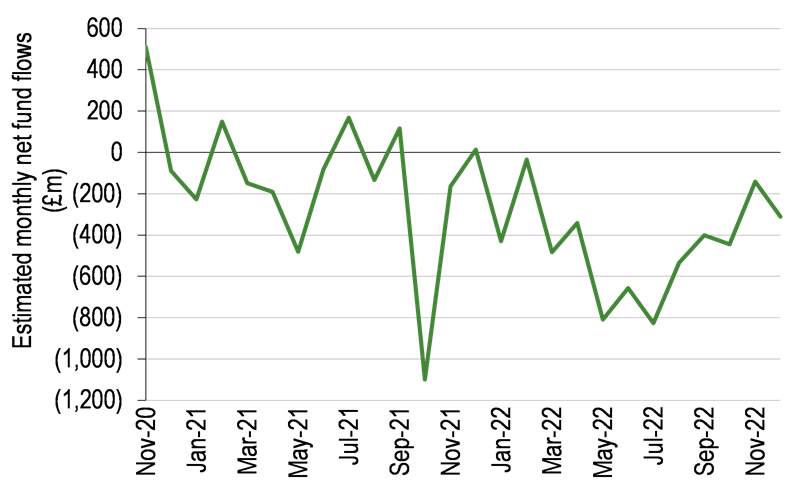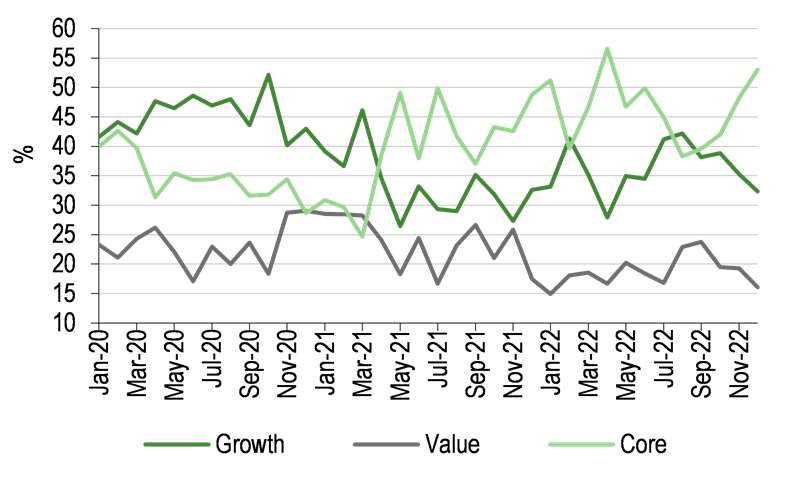Current portfolio positioning
Ross manages this portfolio from a purely bottom-up basis, with stock, sector and country weightings being an end product of where he is finding opportunities rather than being targeted. The portfolio is overweight France and the Netherlands, with key positions in TotalEnergies, a French energy company, and Dutch health, nutrition and bioscience firm Royal DSM. The portfolio has a geographic bias to more internationally focused northern European countries like France, Switzerland, Germany and the Netherlands, with around 77% invested in these areas. There are fewer positions in southern Europe where companies can often be more domestically focused.
Exhibit 4: Portfolio’s geographic exposure vs MSCI Europe ex UK Index (% unless stated)
|
|
Portfolio end- December 2022 |
Portfolio end- December 2021 |
Change (pp) |
Index weight |
Active weight vs index (pp) |
France |
30.0 |
20.0 |
10.0 |
22.2 |
7.8 |
Switzerland |
17.2 |
19.8 |
(2.6) |
20.1 |
(2.9) |
Germany |
16.3 |
14.9 |
1.4 |
16.3 |
0.0 |
Netherlands |
13.2 |
13.6 |
(0.4) |
9.4 |
3.8 |
Italy |
6.0 |
9.2 |
(3.1) |
4.2 |
1.8 |
Denmark |
5.8 |
3.9 |
1.9 |
5.8 |
0.0 |
Spain |
5.4 |
4.7 |
0.7 |
5.0 |
0.4 |
Austria |
4.1 |
5.1 |
(1.0) |
0.5 |
3.6 |
Finland |
1.8 |
1.0 |
0.8 |
2.8 |
(0.9) |
United Kingdom |
1.6 |
4.9 |
(3.3) |
0.3 |
1.3 |
Other Geographies* |
0.0 |
2.9 |
(2.9) |
13.4 |
(13.4) |
|
Source: Henderson EuroTrust, Edison Investment Research. * Includes Sweden, Belgium, Greece, Ireland, Luxembourg, Norway, Portugal, Eastern Europe.
|
The top 10 holdings at the end of December 2022 (Exhibit 5) share a fair amount of similarity with those of a year previously. New holdings TotalEnergies, Sanofi and ASML are new top 10 positions, with idiosyncratic investment theses, and were all initiated into the portfolio in the last 12 months.
Exhibit 5: Top 10 holdings (as at 31 December 2022)
|
Company |
Country |
Sector |
Portfolio weight % |
Index weight |
Active weight vs Index |
31 December 2022 |
31 December 2021 |
TotalEnergies |
France |
Energy |
6.0 |
2.2 |
2.0 |
4.0 |
Novo Nordisk |
Denmark |
Health Care |
5.8 |
3.9 |
2.9 |
2.9 |
Nestle |
Switzerland |
Consumer Staples |
5.3 |
6.3 |
4.4 |
0.9 |
Roche |
Switzerland |
Health Care |
4.9 |
6.3 |
3.0 |
1.8 |
Sanofi |
France |
Health Care |
4.4 |
3.2 |
1.5 |
2.9 |
Unicredit |
Italy |
Financials |
4.2 |
4.6 |
0.4 |
3.9 |
Bawag Group |
Austria |
Financials |
4.1 |
5.1 |
0.0 |
4.1 |
Royal DSM |
Netherlands |
Communication Services |
3.7 |
4.6 |
0.3 |
3.4 |
ASML Holding |
Netherlands |
Information Technology |
3.3 |
2.0 |
3.0 |
0.3 |
Airbus |
France |
Industrials |
3.3 |
0.0 |
0.9 |
2.4 |
Top 10 (% of holdings) |
|
|
45.0 |
38.2 |
|
|
|
Source: Henderson EuroTrust, Edison Investment Research
|
In general, HNE has a bias to quality growth companies. These can be found in a variety of industries and so the overall portfolio is diversified at sector level. According to Morningstar data, HNE has around 30% in both cyclicals (those industries where prospects are historically materially affected by the direction and magnitude of economic growth) and sensitive industries (those industries affected by economic cycles to a lesser degree than cyclicals), with a further 40% in defensives (those industries that are traditionally relatively unaffected by economic cycles). It has had a recent bias to cyclicals compared with peers and the benchmark, but is now paring this back (Exhibit 6), with an increasing allocation to companies in both sensitives (Exhibit 7) and defensives (Exhibit 8).
Cyclical industries include basic materials, consumer cyclicals (or discretionary), financial services and real estate and there are examples of these types of company within the portfolio including Royal DSM, Munich Re and BAWAG Group. Sensitive companies in the portfolio include TotalEnergies, ASML and Airbus.
Exhibit 6: Have cyclicals peaked?
|
Exhibit 7: Sensitives are ticking up
|

|

|
|
|
|
Exhibit 6: Have cyclicals peaked?
|

|
|
|
Exhibit 7: Sensitives are ticking up
|

|
|
|
Despite defensive stocks being an area where valuations can be stretched in times of economic uncertainty and weakness, there are many examples of these types of companies in the portfolio including Nestlé, Novo Nordisk and Enel.
Exhibit 8: Defensives edging up
|

|
|
|
The net result of the changes implemented in 2022 to date has been that the quality of the portfolio has improved, with increases in overall return on invested capital (ROIC), gross and operating margins and reduced debt.
The implications of the cost of living crisis for HNE’s portfolio
The cost of living crisis fuelled by rising input cost inflation has dominated the political and economic landscape in 2022. HNE has exposure to both consumer staples and discretionary holdings. In the consumer discretionary sector, the cost of living crisis is already seeing signs of demand destruction, which is affecting sales and earnings in industries like fashion retailers, home furnishings and improvements. Online fashion companies like ASOS and Zalando, which prospered during the initial months of the COVID pandemic, have seen consumer demand decline. Currently there is limited pure play e-commerce exposure in the portfolio (although there has been more exposure in recent years), little retail and no general retail (food, home, electrical goods, etc). The trust previously held some gaming stocks that were COVID beneficiaries but subsequently performed poorly as China clamped down on gaming activity and the positions were sold. Stocks held in the consumer discretionary area include Adidas, Delivery Hero and HelloFresh.
Exhibit 9: Portfolio sector exposure versus MSCI Europe ex UK Index (% unless stated)
|
|
Portfolio end- December 2022 |
Portfolio end- December 2021 |
Change (pp) |
Index weight |
Active weight vs index (pp) |
Financials |
20.6 |
21.6 |
(0.9) |
17.2 |
3.4 |
Health Care |
16.6 |
15.0 |
1.6 |
16.3 |
0.4 |
Industrials |
13.1 |
12.1 |
1.0 |
16.3 |
(3.2) |
Consumer Staples |
11.7 |
11.3 |
0.5 |
10.6 |
1.2 |
Consumer Discretionary |
9.8 |
15.6 |
(5.9) |
10.9 |
(1.1) |
Information Technology |
9.5 |
7.9 |
1.5 |
9.0 |
0.5 |
Materials |
7.1 |
8.0 |
(0.9) |
6.2 |
0.9 |
Energy |
6.0 |
2.2 |
3.9 |
4.2 |
1.8 |
Communication Services |
5.1 |
5.3 |
(0.1) |
3.6 |
1.5 |
Utilities |
1.9 |
1.0 |
0.8 |
4.7 |
(2.8) |
|
Source: Henderson EuroTrust, Edison Investment Research
|
The portfolio also has luxury consumer exposure in consumer discretionary, which has traditionally been more resilient during downturns or economic stress, despite being the most discretionary of purchases. Arguably, the cost of living crisis has less of an effect on luxury goods as they rely on the ultra-wealthy (a third of their customers provide 80% of revenues), who are less affected by rising costs. The trust holds LVMH and Hermès, which both grew through the COVID crisis and continue to be high-quality businesses, delivering high returns on capital, pricing power and high margins.
Consumer staples traditionally provide defensive characteristics, and the portfolio has had material exposure to the sector previously (Exhibit 11). These companies tend to have pricing power, high margins and defensive growth. They can suffer from downtrading from branded to white label, which can affect earnings. Exposure in the portfolio is via stocks such as Pernod Ricard and Nestlé. There is also relatively modest exposure to self-help/turnaround stories in this area via French dairy-based consumer brands Danone and German personal goods company Beiersdorf, which is akin (albeit on a cheaper rating multiple) to L’Oréal. In both examples, there has been recent changes to the management and business strategy.
Exhibit 10: More financials…
|
Exhibit 11: …less consumer
|

|

|
|
|
|
Exhibit 10: More financials…
|

|
|
|
Exhibit 11: …less consumer
|

|
|
|
The latest European industrials Purchasing Managers’ Index for November was 47.8, a sharp fall from the 58 reading in January 2022, indicating a major decline in confidence. While the outlook for the industrial sector is mixed, the manager has focused on energy efficiency via Swiss company ABB and the Finnish company Metso, which provides exposure to materials used for EV development such as lithium and cobalt; both companies play into the sustainability theme. There is no residential construction exposure as a result of consumer affordability concerns. Globally, infrastructure projects and orders have stalled, and the trust no longer has exposure to this subsector. The trust continues to own Germany-based Kion, which is involved in warehouse automation, and is seeing headwinds from a high raw material cost base, supply chain issues and demand weakness.
Semiconductor companies can be an early indicator of slowing demand. There have been profit warnings this year from the likes of Micron and also a material drop in chip and related tech exports from Taiwan and South Korea. Less consumer demand for smartphones leads to slowing demand for chips that go into handsets. There was very limited exposure at the start of the year, but now there are two small additional positions in semiconductor equipment manufacturer BE Semiconductor Industries and ASM. Despite the current cyclically driven reduction in end market demand, semiconductors remain a long-term structural growth industry with high operating profit margins and return on capital. The recent share price weakness provided an opportunity to buy into this long-term growth on attractive valuations.
Ross has been finding opportunities in financials (Exhibit 10) and he began increasing the weighting in Q220 as he saw the sector as being undervalued and perceived as low quality, but a rising rate environment provides a natural tailwind for margins for the industry, previously absent for so long with the major central banks’ zero interest rate policy. In terms of banks, the portfolio has the Austrian BAWAG and Italian UniCredit. Other financial positions within the portfolio include Munich Re, Swiss private markets group Partners Group, which has had a tough 2022 thus far, and the more recently added Deutsche Börse, a potential beneficiary from market volatility. Overall, the financials weighting has been a positive contributor to recent performance.
One area the manager is avoiding is autos. The auto industry is affected by an economic slowdown and the cost of living crisis, and tends to have extremely cyclical margins and demand while having large, fixed cost bases. In addition, supply bottlenecks are easing, which will reduce pricing and impact margins. Twelve months ago, the trust owned one original equipment manufacturer – Stellantis and one auto parts company (Faurecia), and both were sold, in July and March 2022, on concerns over the earnings and margin cycle deteriorating.
































